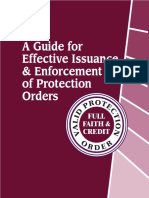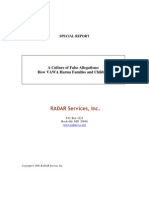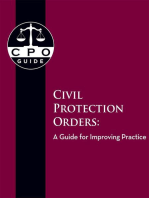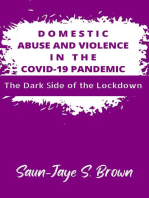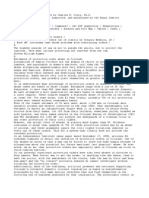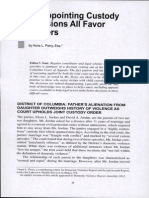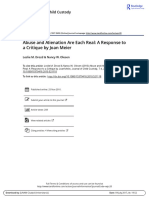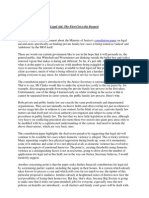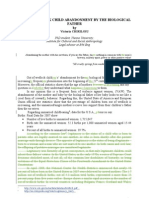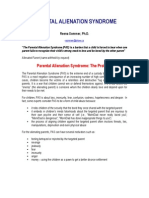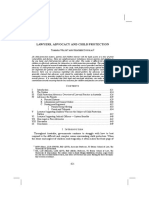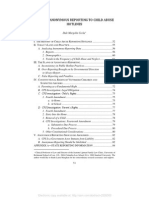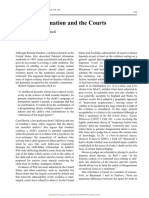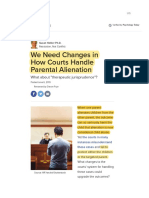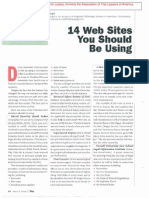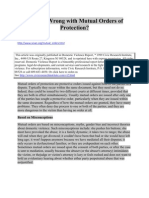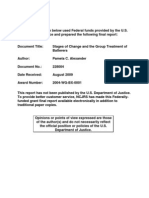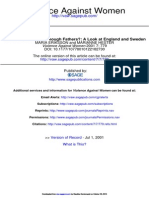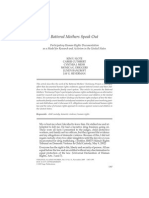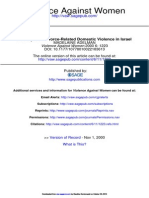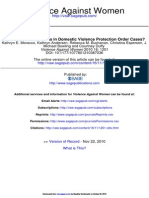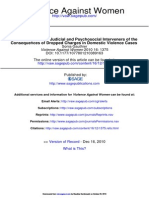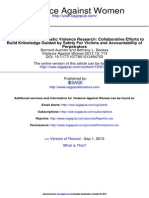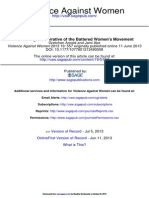Professional Documents
Culture Documents
VAWA - Title 2 - The Entire MISSING Section of The VAWA Identifying Use of PAS Legal Strategies As Violence Against Women Which Endangers Children
Uploaded by
AnotherAnonymomOriginal Title
Copyright
Available Formats
Share this document
Did you find this document useful?
Is this content inappropriate?
Report this DocumentCopyright:
Available Formats
VAWA - Title 2 - The Entire MISSING Section of The VAWA Identifying Use of PAS Legal Strategies As Violence Against Women Which Endangers Children
Uploaded by
AnotherAnonymomCopyright:
Available Formats
F:\MDB\97COMM\JUD\MSPAK2.
002
1 2 3 4 5 6 7 8 9 10 11 12 13 14 15 16 17 18 19 20 21 22 23 24 25
TITLE IILIMITING THE FECTS OF VIOLENCE CHILDREN
SEC. 201. FINDINGS.
EFON
(1) Witnessing domestic violence has a devastating impact on children, placing them at high risk for anxiety, depression, substance abuse and suicide. These children may exhibit more aggressive, antisocial, fearful, and inhibited behaviors. (2) Children exposed to domestic violence often have problems in school. (3) Domestic violence is strongly correlated with child abuse. Studies have found that between 50 and 70 percent of men who abuse their female partners also abuse their children. (4) Boys who witness parental abuse during their childhood are at a higher risk of being physically aggressive in dating and marital relationships. (5) Girls are 3 times as likely as boys to be victims of sexual abuse. (6) Children often fail to report child sexual abuse because of the fear that disclosure will bring worse consequences than being victimized again, including consequences from the family, feeling guilty for consequences to the perpetrator, and fear of sub-
February 12, 1998 (6:07 p.m.)
F:\MDB\97COMM\JUD\MSPAK2.002
2 1 2 3 4 5 6 7 8 9 10 11 12 13 14 15 16 17 18 19 20 21 22 23 24 25 sequent retaliation from the perpetrator. Victims may also feel that the abuse is their fault. (7) Women are at an increased risk of harm after separation from an abusive partner. Up to 75 percent of all domestic assaults reported to law enforcement agencies were inflicted after the separation of the couple. (8) Children are also at increased risk of harm during separation. In 1 study, 34 percent of women in shelters and callers to hotlines reported threats of kidnapping, 11 percent reported that the batterer had kidnapped the child for some period, and 21 percent reported that threats of kidnapping forced the victim to return to the batterer. (9) According to a 1996 report by the American Psychological Association (APA), which Congress views as authoritative on matters of domestic violence and child custody and visitation determinations, custody and visitation disputes are more frequent when there is a history of domestic violence. Further, fathers who batter mothers are twice as likely to seek sole custody of their children and they may misuse the legal system as a forum for continuing abuse through harassing and retaliatory legal actions.
February 12, 1998 (6:07 p.m.)
F:\MDB\97COMM\JUD\MSPAK2.002
3 1 2 3 4 5 6 7 8 9 10 11 12 13 14 15 16 17 18 19 20 21 22 23 24 25 (10) The need for supervised visitation centers far exceeds the number of available programs, resulting in courts ordering unsupervised visitation and endangering parents and children. (11) One-third of high school and college age students experience violence with an intimate partner. (12) A 1992 study concluded that being abused or neglected in childhood increases the likelihood of arrest for girls and women by 77 percent. (13) Although courts should diligently protect the interests of both parents in frequent and continuing contact with their children, in the case where 1 parent has committed domestic violence against the other parent, protection of the other parent and the children is a vital consideration that should take precedence. (14) Every State has legislation or judicial decisions that base its custody determinations on what is in the best interests of the child, and the vast majority of States include considerations of domestic violence as a factor in determining the best interests of the child. (15) The National Council of Juvenile and Family Court Judges includes the option of super-
February 12, 1998 (6:07 p.m.)
F:\MDB\97COMM\JUD\MSPAK2.002
4 1 2 3 4 5 6 7 8 9 10 11 12 13 14 15 16 17 18 19 20 21 22 23 24 25 vised visitation centers in their Model Code on Domestic and Family Violence. (16) Despite the perception that mothers always win custody cases, studies show that fathers who contest custody win sole or joint custody in 40 to 70 percent of cases. (17) According to the APA, there is no reliable empirical data to support the so-called phenomenon of parental alienation syndrome, although courts and custody evaluators frequently use such terms to discount childrens reasonable fear and anger toward a violent parent. This syndrome and similar ones are used almost exclusively against women. (18) The documented rate of any child abuse allegations in custody cases is approximately 2 percent, and there is no evidence that false accusations are more common in the context of custody litigation. (19) Congress never intended that the Parental Kidnapping Prevention Act be used to prohibit an abused or protective parent from protecting themselves or their child by relocation to a place of safety. (20) When domestic violence is or has been present in the relationship, shared parenting ar-
February 12, 1998 (6:07 p.m.)
F:\MDB\97COMM\JUD\MSPAK2.002
5 1 2 3 4 5 6 7 8 9 10 11 12 13 14 15 16 17 18 19 20 21 22 23 24 rangements, couples counseling, or mediation arrangements only exacerbate the difficulties of the children and give the abusive parent more tools to victimize members of the family.
Subtitle ASafe Havens for Children
SEC. 211. PURPOSES.
The purposes of section 212 are (1) to provide secure locations for visitation and visitation exchange; (2) to protect children from the trauma of witnessing domestic violence, or experiencing abduction, injury, or death during parent and child visitation and/or visitation exchanges; (3) to protect victims of domestic violence from experiencing further violence, abuse, and threats during child visitation and/or visitation exchanges; (4) to protect children from the trauma of experiencing sexual assault or other forms of physical assault and abuse during parent and child visitation and/or visitation exchanges; and (5) to provide an ongoing safe haven for parents and children during visitation or visitation exchanges to promote continuity and stability.
February 12, 1998 (6:07 p.m.)
F:\MDB\97COMM\JUD\MSPAK2.002
6 1 2 3
SEC. 212. GRANTS TO PROVIDE FOR SUPERVISED VISITATION CENTERS.
(a) GRANTS.The Attorney General is authorized to
4 award grants to public or private nonprofit nongovern5 mental entities, including tribally chartered organizations 6 and nonprofit organizations operating within the bound7 aries of an Indian reservation whose governing body re8 flects the populations served, to assist such entities in es9 tablishing and operating supervised visitation centers for 10 the purposes of facilitating supervised visitation and visi11 tation exchange. At least 50 percent of all grants awarded 12 shall be for contracts and cooperative agreements with 13 public or private nonprofit, nongovernmental entities, in14 cluding entities receiving court referrals. 15 (b) CONSIDERATIONS.In awarding such grants,
16 contracts, and cooperative agreements under paragraph 17 (1), the Attorney General shall take into account 18 19 20 21 22 23 24 25 (1) the number of families to be served by the proposed visitation center to be established under the grant, contract, or agreement; (2) the extent to which supervised visitation centers serve underserved populations as that term is defined in section 2003(7) of the Omnibus Crime Control and Safe Streets Act of 1968 (42 U.S.C. 3796gg2(7));
February 12, 1998 (6:07 p.m.)
F:\MDB\97COMM\JUD\MSPAK2.002
7 1 2 3 4 5 6 7 8 9 10 11 12 13 14 15 16 17 18 19 20 21 22 23 24 25 (3) the extent to which the applicant demonstrates cooperation and collaboration with nonprofit, nongovernmental entities in the local community served, including the State domestic violence and sexual assault coalitions, local shelters and programs for domestic violence victims, including programs providing legal assistance to domestic violence victims and rape crisis centers; (4) the extent to which the applicant demonstrates coordination and collaboration with State and local court systems, including mechanisms for communication and referral; and (5) the extent to which the applicant demonstrates implementation of domestic violence and sexual assault training for all employees. (c) USE OF FUNDS. (1) IN
GENERAL.Amounts
provided under a
grant, contract, or cooperative agreement awarded under this subsection shall be used to establish supervised visitation centers and for the purposes described in section 1(b). In using such amounts, grantees and persons awarded a contract or cooperative agreement shall target the economically disadvantaged and those individuals who could not otherwise afford such visitation services. Individuals
February 12, 1998 (6:07 p.m.)
F:\MDB\97COMM\JUD\MSPAK2.002
8 1 2 3 4 5 6 7 8 9 10 11 12 13 14 15 16 17 18 19 20 21 22 23 24 25 shall be permitted to use the services provided by the center on a sliding fee basis. For purposes of determining qualification for sliding scale fees, only the individual income will be considered and no spousal or household income will be counted. (2) REGULATIONS
MENTS.The AND APPLICANT REQUIRE-
Attorney General shall award grants,
contracts, and cooperative agreements under this section in accordance with such regulations as the Attorney General may promulgate. The regulations shall establish a multi-year grant process. The Attorney General shall give priority in awarding grants, contracts, and cooperative agreements under this title to entitles in States that consider domestic violence in making a custody decision. An applicant awarded such a grant, contract, or cooperative agreement shall (A) for applicants under section 201(b)(1) or (2), (i) demonstrate recognized expertise in the area of domestic violence and a record of high quality service to victims of domestic violence; and (ii) demonstrate through a memorandum of understanding collaboration with and support of the State domestic violence coalition and
February 12, 1998 (6:07 p.m.)
F:\MDB\97COMM\JUD\MSPAK2.002
9 1 2 3 4 5 6 7 8 9 10 11 12 13 14 15 16 17 18 19 20 21 22 23 24 25 local domestic violence shelter or program in the locality in which the supervised visitation center will be operated; (B) for applicants under section 201(b)(3), (i) demonstrate recognized expertise in the area of child sexual assault and abuse and a record of high quality service to victims of sexual assault; and (ii) demonstrate through a memorandum of understanding collaboration with and support of the State sexual assault coalition and local rape crisis center or sexual assault program in the locality where the supervised visitation center will be operated; (C) provide supervised visitation and visitation exchange services over the duration of a court order to promote continuity and stability; (D) demonstrate that adequate security measures, including adequate facilities, procedures and personnel capable of preventing violence, are in place for the operation of supervised visitation; and (E) describe in detail the standards by which the supervised visitation center will operate.
February 12, 1998 (6:07 p.m.)
F:\MDB\97COMM\JUD\MSPAK2.002
10 1 (d) REPORTING.Not later than 60 days after the
2 end of each fiscal year, the Attorney General shall report 3 to Congress information concerning 4 5 6 7 8 9 10 11 12 13 14 15 16 17 18 19 20 21 22 23 24 25 (A) the number of individuals served and the number of individuals turned away from services categorized by State, the number of individuals from underserved populations (as such term is defined in section 2003(7) of the Omnibus Crime Control and Safe Streets Act of 1968 (42 U.S.C. 3796gg2(7))) served and turned away from services, and the type of presenting problems that underlie the need for supervised visitation or visitation exchange, such as domestic violence, child sexual abuse, emotional abuse or other physical abuse, or a combination of such factors; (B) the numbers of supervised visitations or visitation exchanges ordered during custody determinations under a separation or divorce decree, under a protection order, through child protection services, through other social services agencies or by any other order of a civil, criminal, juvenile, or family court; (C) the process by which children or abused partners are protected during visita-
February 12, 1998 (6:07 p.m.)
F:\MDB\97COMM\JUD\MSPAK2.002
11 1 2 3 4 5 6 7 8 9 10 11 12 13 14 15 16 17 18 19 20 21 22 23 24 25 tions, temporary custody transfers and other activities for which the supervised visitation centers are created; (D) safety and security problems occurring during the reporting period during supervised visitations or at visitation centers including the number of parental abduction cases; (E) the number of parental abduction cases in a judicial district using supervised visitation services, both as identified in criminal prosecution and custody violations; (F) program standards across the country that are in place for operating a supervised visitation center; and (G) any other appropriate information designated in regulations promulgated by the Secretary. (e) AUTHORIZATION OF APPROPRIATIONS. (1) IN
GENERAL.For
the purpose of awarding
grants, contracts, and cooperative agreements under this section, there are authorized to be appropriated $75,000,000 for fiscal year 1999, $85,000,000 for fiscal year 2000, $95,000,000 for fiscal year 2001, $105,000,000 for fiscal year 2002, and
$115,000,000 for fiscal year 2003.
February 12, 1998 (6:07 p.m.)
F:\MDB\97COMM\JUD\MSPAK2.002
12 1 2 3 4 5 6 7 8 9 10 11 12 13 (2) DISTRIBUTION.Of the amounts appropriated under subparagraph (A) for each fiscal year, not less than 95 percent shall be used to award grants, contracts, or cooperative agreements. At least 5 percent of the funds appropriated under this subtitle shall be used for grants to tribal organizations.
Subtitle BViolence Women Prevention Youth in Schools
VENTION AMONG YOUTH.
Against Among
SEC. 221. GRANTS FOR VIOLENCE AGAINST WOMEN PRE-
(a) IN GENERAL.For purposes of this section, the
14 Secretary of Education shall in consultation with the Sec15 retary of the Department of Health and Human Services, 16 implement a program for education of young people about 17 violence against women. 18 19 20 21 22 23 24 25 (b) USE OF FUNDS. (1) The Secretary shall make grants to primary, middle, and secondary schools to develop, adopt, implement, and disseminate educational curricula and materials on violence against women, including training for school personnel. Such curricula and materials should be developed, adopted, implemented, and disseminated in consulate and collabo-
February 12, 1998 (6:07 p.m.)
F:\MDB\97COMM\JUD\MSPAK2.002
13 1 2 3 4 5 6 7 8 9 10 11 12 13 14 15 16 17 18 19 20 21 22 23 24 25 ration with experts on violence against women and girls from the educational, legal, cultural competence, youth and victim advocacy fields, such as battered womens shelters and State domestic violence coalitions, State sexual assault coalitions and rape crisis centers and community-based youth organizations. Priority shall be given to initiatives that address particularly the needs of underserved communities that may be recipients of the curricula and materials and training. (2) The Secretary shall disseminate any existing Department of Education policy guidance regarding preventing and remedying violence against women in schools. (3) The Secretary shall study and report to Congress recommendations regarding policies for primary, middle, and secondary schools in screening and referring children for services when children may be experiencing the effects of domestic violence or sexual assault. The study shall consider victim safety and confidentiality as significant factors in any policy recommendations. (4) The Secretary shall study and report to Congress the link between the victimization of girls and their perpetration of crimes. This study will ex-
February 12, 1998 (6:07 p.m.)
F:\MDB\97COMM\JUD\MSPAK2.002
14 1 2 3 4 5 6 7 8 9 10 amine the nature of the link, types of crimes in which girls who are victims of domestic violence and sexual assault engage, and the short- and long-term effect of girls violent victimization. In addition, the report will explore the extent to which local, State, and Federal policies that govern social welfare, health education, and juvenile justice systems address the needs of girls as victims of domestic violence or sexual assault. (c) AUTHORIZATION
OF
APPROPRIATIONS.There is
11 authorized to be appropriated to carry out this section 12 $10,000,000 for each of fiscal years 1999, 2000, 2002, 13 and 2003. 14 15 16
Subtitle CFamily Safety
SEC. 231. SHORT TITLE.
This subtitle may be cited as the Family Safety
17 Act. 18 19
SEC. 232. FINDINGS AND PURPOSES.
(a) FINDINGS.Section 7(a) of the Parental Kidnap-
20 ing Prevention Act of 1980 (94 Stat. 3568; 42 U.S.C. 21 1305 note) is amended 22 23 24 25 (3); (2) by striking the period at the end of paragraph (4) and inserting a semicolon; and (1) by striking and at the end of paragraph
February 12, 1998 (6:07 p.m.)
F:\MDB\97COMM\JUD\MSPAK2.002
15 1 2 3 4 5 6 7 8 9 10 11 12 13 (3) by inserting after paragraph (4) the following new paragraphs: (5) existing Federal and State laws are inadequate to protect parents from domestic violence and to protect children from sexual assault and may punish them when they seek to protect themselves; and (6) failures of State judicial and child protection systems may result in the inappropriate placement of children in the custody of abusive parents or punishment of nonabusing parents who attempt to protect themselves or their children.. (b) CONCLUSION.Section 7(b) of such Act is
14 amended by inserting to establish standards to prevent 15 children from being returned to abusive parents, after 16 with such disputes,. 17 18 ed 19 20 21 22 23 24 ing: (3) promote cooperation between State and tribal courts to protect parents and children from an (1) by redesignating paragraphs (3) through (6) as paragraphs (5) through (8), respectively; (2) by inserting after paragraph (2) the follow(c) PURPOSES.Section 7(c) of such Act is amend-
February 12, 1998 (6:07 p.m.)
F:\MDB\97COMM\JUD\MSPAK2.002
16 1 2 3 4 5 6 7 8 9 10 11 12 13 14 15 16 17 18 19 20 21 22 incident or pattern of domestic violence or sexual assault; (4) promote realistic and protective standards for interstate relocation when parents dispute custody, particularly in cases where there is domestic violence or sexual assault;; (3) in paragraph (7) (as so redesignated), by inserting before the semicolon at the end the following: , consistent with not endangering or inappropriately punishing parents who are victims of domestic violence or children who are victims of sexual assault; and (4) in paragraph (8) (as so redesignated), by inserting before the period at the end the following: or to abuse the child or exert coercive control over the other parent, except when the removal is justifiable in an attempt to protect the parent or any child in the parents care.
SEC. 233. DEFENSE TO CRIMINAL CUSTODIAL INTERFERENCE OR PARENTAL ABDUCTION
CHARGE OR CLAIM.
Section 1073 of title 18, United States Code, is
23 amended by striking Whoever moves and inserting (a) 24 Whoever moves and by adding at the end the following:
February 12, 1998 (6:07 p.m.)
F:\MDB\97COMM\JUD\MSPAK2.002
17 1 (b) For any charge of parental abduction, of custo-
2 dial interference, or of felony criminal contempt of court 3 related to an underlying child custody or visitation deter4 mination, that would otherwise provide a basis for pros5 ecution under this section, it shall be a defense to such 6 prosecution that the individual against whom this section 7 is invoked 8 9 10 11 12 13 14 15 16 17 18 19 20 21 22 23 24 (1) acted pursuant to the provisions of a court order valid when and where issued (A) which granted the defendant legal custody or visitation rights; (B) which was obtained in compliance with section 1738A of title 28; (C) which is not inconsistent with such section or with the Uniform Child Custody Jurisdiction Enforcement Act as promulgated by the Uniform Law Commissioners; and (D) which was in effect at the time the defendant left the State; (2) was fleeing an incident or pattern of domestic violence or sexual assault of the child; (3) would otherwise have a defense under the terms of the International Parental Kidnapping Prevention Act (18 U.S.C. 1204).
February 12, 1998 (6:07 p.m.)
F:\MDB\97COMM\JUD\MSPAK2.002
18 1 (c) The Attorney General shall issue regulations to
2 assist the United States Attorneys and the Federal Bu3 reau of Investigation in determining when to decline to 4 initiate or to terminate an investigation or prosecution 5 under subsection (b) due to the potential availability of 6 any defense.. 7 8 9
SEC. 234. FULL FAITH AND CREDIT GIVEN TO CHILD CUSTODY DETERMINATIONS.
(a) SECTION INTENT.Section 1738A(a) of title 28,
10 United States Code, is amended by adding at the end the 11 following: This section is intended to preempt any incon12 sistent State law and to apply to every proceeding in the 13 United States or its territories that is not governed by 14 inconsistent aspects of any treaty to which the United 15 States Government is a signatory or has ratified that in16 volves custody and visitation concerning a minor child. 17 Any provisions of a protection order regarding the custody 18 and visitation of a minor child, whether consensual or not, 19 otherwise consistent with section 2265 of title 18 and with 20 this section shall be given full faith and credit by the 21 courts of any State where the party who sought the order 22 seeks enforcement.. 23 (b) DEFINITIONS.Section 1738A(b) of such title is
24 amended
February 12, 1998 (6:07 p.m.)
F:\MDB\97COMM\JUD\MSPAK2.002
19 1 2 3 4 5 6 7 8 9 10 11 12 13 14 15 16 17 18 19 20 21 22 23 24 ing: (4) domestic violence includes acts or threats of violence, not including acts of self defense, committed by a current or former spouse of the victim, by a person with whom the victim shares a child in common, by a person who is cohabitating with or has cohabitated with the victim, by a person who is or has been in a continuing social relationship of a romantic or intimate nature with the victim, by a person similarly situated to a spouse of the victim under the domestic or family violence laws of the jurisdiction, or by any other person against a victim who is protected from that persons acts under the domestic or family violence laws of the jurisdiction; (5) sexual assault means any conduct proscribed by chapter 109A of title 18, United States Code, whether or not the conduct occurs in the special maritime and territorial jurisdiction of the United States or in a Federal prison and includes both assaults committed by offenders who are strangers to the victim and assaults committed by offenders who are known to the victim or related by blood or marriage to the victim;; (1) by inserting after paragraph (3) the follow-
February 12, 1998 (6:07 p.m.)
F:\MDB\97COMM\JUD\MSPAK2.002
20 1 2 3 4 5 6 7 8 9 10 11 12 13 14 15 16 17 18 19 20 21 22 23 24 (2) by redesignating paragraphs (4), (5), and (6) as paragraphs (7), (8), and (9), respectively; (3) by redesignating paragraph (7) as paragraph (10) and by striking and after the semicolon; (4) by inserting after paragraph (9) (as so redesignated) the following: (11) predominant aggressor means the individual who has been determined to be the principal perpetrator of violence, by factors including (A) history of domestic violence; (B) relative severity of the injuries inflicted on each person; (C) the likelihood of future injury to each person; (D) whether one of the persons acted in self-defense; and/or (E) the degree to which one of the persons has acted with more deliberate intent to control, isolate, intimidate, emotionally demean, or cause severe pain or injury, or fear of harm to the other or a third person; and (5) by redesignating paragraph (8) as paragraph (12).
February 12, 1998 (6:07 p.m.)
F:\MDB\97COMM\JUD\MSPAK2.002
21 1 (c) CONDITION
FOR
CUSTODY DETERMINATION.
2 Section 1738A(c)(2)(C) of such title is amended 3 4 5 6 7 (1) by striking he and inserting the child, or a sibling or parent of the child,; and (2) by inserting , including acts of domestic violence by the other parent after abuse. (d) JURISDICTION.Section 1738A(d) of such title
8 is amended by inserting before the period at the end the 9 following: , except that after 2 years have passed while 10 a child is living in another State after relocation consistent 11 with a court order or due to domestic violence or sexual 12 assault of the child, the court of the original State shall 13 decline jurisdiction provided that the courts of the new 14 State would have personal jurisdiction over the other par15 ent under that States law. 16 (e) CHILD CUSTODY DETERMINATIONS.Section
17 1738A of such title is amended by adding at the end the 18 following: 19 (h) A court may decline to exercise jurisdiction on
20 behalf of a parent who has engaged in domestic violence 21 as a predominant aggressor, if a court of another State 22 has emergency jurisdiction under subsection (c)(2)(C)(ii). 23 A court may decline to exercise jurisdiction on behalf of 24 a parent who has wrongfully taken the child from a State 25 without justification, or engaged in similar unjustifiable
February 12, 1998 (6:07 p.m.)
F:\MDB\97COMM\JUD\MSPAK2.002
22 1 conduct, unless no other State would have jurisdiction 2 under any provision of subsection (c). 3 4 5 6 7 8 9 10 11 12 13 14 15 16 17 18 19 20 21 22 23
Subtitle DDomestic Violence and Children
SEC. 241. CHILD CUSTODY, CHILD ABUSE, AND VICTIMS OF DOMESTIC VIOLENCE.
It is the sense of Congress that (1) for purposes of determining child custody, it is in the best interest of children to have a presumption that children should have their main physical residence with their primary caretaker parent unless that parent is unfit; (2) for purposes of determining child custody, it is not in the best interest of children to (A) force parents to share custody over the objection of one or both parents when there is a history of domestic violence; (B) punish abused or protective parents who protect themselves or their children; (C) presume that allegations of domestic violence or child sexual assault are likely to be made falsely or for tactical advantage during custody and divorce proceedings; and
February 12, 1998 (6:07 p.m.)
F:\MDB\97COMM\JUD\MSPAK2.002
23 1 2 3 4 5 6 7 8 9 10 11 12 13 14 15 16 17 18 19 20 21 22 23 (D) make friendly parent provisions a factor when there is abuse by one parent against the other or a child; (3) child abuse and child sexual abuse allegations should be fully and impartially investigated regardless of when they are raised or whether the child has withdrawn the allegation; (4) States should be far more protective of victims of domestic violence and sexual assault in custody and visitation determinations and not order mediation, couples counseling, shared custody, mutual orders of protection, unsupervised visitation, or other measures when they may endanger the other parent or the child; and (5) States should provide training in domestic violence and sexual assault, as they impact custody, child support and visitation determinations, to all professionals who interact with children and parents (including judges, attorneys, guardians ad litem and other individuals appointed to represent children, therapists, and mental health professionals, custody evaluators, child protective services personnel, and court appointed special advocates).
February 12, 1998 (6:07 p.m.)
F:\MDB\97COMM\JUD\MSPAK2.002
24 1 2 3 4
Subtitle EChild Abuse Accountability
SEC. 251. SHORT TITLE.
This subtitle may be cited as the Child Abuse Ac-
5 countability Act. 6 7 8 9
FITS
SEC. 252. AMENDMENTS TO TITLE I OF THE EMPLOYEE RETIREMENT INCOME SECURITY ACT OF 1974.
(a) CREATION OR ASSIGNMENT OF RIGHTS TO BENEUNDER QUALIFIED CHILD ABUSE ORDERS.Sec-
10 tion 206(d)(3)(A) of the Employee Retirement Income Se11 curity Act of 1974 (29 U.S.C. 1056(d)(3)(A)) is amend12 ed 13 14 15 16 17 18 19 20 21 (1) by inserting or a child abuse order after a domestic relations order; (2) by inserting or a qualified child abuse order after a qualified domestic relations order; and (3) by inserting or any qualified child abuse order after any qualified domestic relations order. (b) QUALIFIED CHILD ABUSE ORDERS.Section
22 206(d)(3)(B) of such Act (29 U.S.C. 1056(d)(3)(B)) is 23 amended
February 12, 1998 (6:07 p.m.)
F:\MDB\97COMM\JUD\MSPAK2.002
25 1 2 3 4 5 6 7 8 9 10 11 12 13 14 15 16 17 18 19 20 21 22 23 24 (1) in clause (i), by striking the term and inserting The term, and by striking , and at the end and inserting a period; (2) in clause (ii), by striking the term and inserting The term; and (3) by adding at the end the following new clauses: (iii) The term qualified child abuse order means a child abuse order (I) which creates or recognizes the existence of an alternate payees right to, or assigns to an alternate payee the right to, receive all or a portion of the benefits payable with respect to a participant under a plan, and (II) with respect to which the requirements of subparagraphs (C) and (D) are met. (iv) The term child abuse order means any court order or other similar process for the enforcement of a judgment rendered against a participant or beneficiary under a plan for physically, sexually, or emotionally abusing a child. For purposes of this clause
February 12, 1998 (6:07 p.m.)
F:\MDB\97COMM\JUD\MSPAK2.002
26 1 2 3 4 5 6 7 8 9 10 11 12 13 (c) (I) The term judgment rendered for physically, sexually, or emotionally abusing a child means any legal claim perfected through a final enforceable judgment, which claim is based in whole or in part upon the physical, sexual, or emotional abuse of a child, whether or not that abuse is accompanied by other actionable wrongdoing, such as sexual exploitation or gross negligence. (II) The term child means an individual under 18 years of age.. EXEMPTION FROM PREEMPTION.Section
14 514(b)(7) of such Act (29 U.S.C. 1144(b)(7)) is amended 15 by inserting or qualified child abuse orders (within the 16 meaning of section 206(d)(3)(B)(iii)) before the period. 17 (d) CONFORMING AMENDMENTS.Section 206(d)(3)
18 of such Act (29 U.S.C. 1056(d)(3)) is amended 19 20 21 22 23 24 25 (1) in subparagraph (C), by inserting or child abuse order after A domestic relations order; (2) in subparagraph (D), by inserting or child abuse order after A domestic relations order; (3) in subparagraph (E)(i), by inserting or child abuse order after A domestic relations order;
February 12, 1998 (6:07 p.m.)
F:\MDB\97COMM\JUD\MSPAK2.002
27 1 2 3 4 5 6 7 8 9 10 11 12 13 14 15 16 17 18 19 20 21 22 23 24 (4) in subparagraph (G)(i), by inserting or child abuse order after any domestic relations order, by striking domestic relations orders in subclause (I) and inserting such an order, and by inserting or a qualified child abuse order in subclause (II) after a qualified domestic relations order; (5) in subparagraph (G)(ii), by inserting and child abuse orders after domestic relations orders, and by inserting or child abuse order after domestic relations order each place it appears in subclauses (II) and (III); (6) in subparagraph (H)(i), by inserting or whether a child abuse order is a qualified child abuse order after whether a domestic relations order is a qualified domestic relations order, and by inserting or a qualified child abuse order after to be a qualified domestic relations order; (7) in subparagraph (H)(ii), by inserting or a qualified child abuse order after a qualified domestic relations order; (8) in subparagraph (H)(iii), by inserting (in the case of a domestic relations order) or a qualified child abuse order (in the case of a child abuse
February 12, 1998 (6:07 p.m.)
F:\MDB\97COMM\JUD\MSPAK2.002
28 1 2 3 4 5 6 7 8 9 10 11 12 13 14 15 16 17 18 19 20 21 22 order) after a qualified domestic relations order each place it appears in subclauses (I) and (II); (9) in subparagraph (H)(iv), by inserting or a qualified child abuse order after a qualified domestic relations order; (10) in subparagraph (H)(v), by inserting or child abuse order after the domestic relations order; (11) in subparagraph (I)(i), by inserting or child abuse order after a domestic relations order, and by inserting or qualified child abuse order, respectively after a qualified domestic relations order; (12) in subparagraph (J), by inserting or a qualified child abuse order after a qualified domestic relations order; (13) in subparagraph (K), by inserting or child abuse order after a domestic relations order; and (14) in subparagraph (M), by inserting or a qualified child abuse order after a qualified domestic relations order.
February 12, 1998 (6:07 p.m.)
F:\MDB\97COMM\JUD\MSPAK2.002
29 1 2 3 4
FITS
SEC. 253. AMENDMENTS TO THE INTERNAL REVENUE CODE OF 1986.
(a) CREATION OR ASSIGNMENT OF RIGHTS TO BENEUNDER QUALIFIED CHILD ABUSE ORDERS.Sub-
5 paragraph (B) of section 401(a)(13) of the Internal Reve6 nue Code of 1986 (relating to assignment of benefits) is 7 amended 8 9 10 11 12 13 14 15 (1) by inserting OR after DOMESTIC ing; (2) by inserting or a child abuse order after a domestic relations order; and (3) by inserting or a qualified child abuse order after a qualified domestic relations order. (b) QUALIFIED CHILD ABUSE ORDERS.Section
CHILD ABUSE ORDERS
RELATIONS ORDERS
in the head-
16 414(p) of such Code (defining qualified domestic relations 17 order) is amended 18 19 20 21 22 23 24 25 26
February 12, 1998 (6:07 p.m.)
(1) in the heading, by inserting AND QUALIFIED
CHILD ABUSE ORDER after ORDER; and
(2) in paragraph (1), by adding at the end the following new subparagraphs: (C) QUALIFIED
CHILD ABUSE ORDER.
The term qualified child abuse order means a child abuse order (i) which creates or recognizes the existence of an alternate payees right to,
F:\MDB\97COMM\JUD\MSPAK2.002
30 1 2 3 4 5 6 7 8 9 10 11 12 13 14 15 16 17 18 19 20 21 22 23 24 25 or assigns to an alternate payee the right to, receive all or a portion of the benefits payable with respect to a participant under a plan, and (ii) with respect to which the requirements of paragraphs (2) and (3) are met. (D) CHILD (i) IN
ABUSE ORDER. GENERAL.The
term child
abuse order means any court order or other similar process for the enforcement of a judgment rendered against a participant or beneficiary under a plan for physically, sexually, or emotionally abusing a child. (ii) DEFINITIONS.For purposes of this subparagraph (I) The term judgment rendered for physically, sexually, or emotionally abusing a child means any legal claim perfected through a final enforceable judgment, which claim is based in whole or in part upon the physical, sexual, or emotional abuse of a child, whether or not that abuse is
February 12, 1998 (6:07 p.m.)
F:\MDB\97COMM\JUD\MSPAK2.002
31 1 2 3 4 5 6 accompanied by other actionable
wrongdoing, such as sexual exploitation or gross negligence. (II) The term child means an individual under 18 years of age.. (c) CONFORMING AMENDMENTS.Subsection (p) of
7 section 414 of such Code is amended 8 9 10 11 12 13 14 15 16 17 18 19 20 21 22 23 24 25 (1) in paragraph (2), by inserting or child abuse order after A domestic relations order; (2) in paragraph (3), by inserting or child abuse order after A domestic relations order; (3) in paragraph (4)(A), by inserting or child abuse order after a domestic relations order; (4) in paragraph (6)(A), by inserting or child abuse order after any domestic relations order, by striking domestic relations orders in clause (i) and inserting such an order, and by inserting or a qualified child abuse order in clause (ii) after a qualified domestic relations order; (5) in paragraph (6)(B), by inserting and child abuse orders after domestic relations orders; (6) in paragraph (7)(A), by inserting or whether a child abuse order is a qualified child abuse order after whether a domestic relations
February 12, 1998 (6:07 p.m.)
F:\MDB\97COMM\JUD\MSPAK2.002
32 1 2 3 4 5 6 7 8 9 10 11 12 13 14 15 16 17 18 19 20 21 22 23 order is a qualified domestic relations order, and by inserting or a qualified child abuse order after to be a qualified domestic relations order; (7) in paragraph (7)(B), by inserting OR
QUALIFIED CHILD ABUSE ORDER
in the heading
after QUALIFIED
DOMESTIC RELATIONS ORDER,
and by inserting or a qualified child abuse order after a qualified domestic relations order; (8) in paragraph (7)(C), by inserting (in the case of a domestic relations order) or a qualified child abuse order (in the case of a child abuse order) after a qualified domestic relations order each place it appears in clauses (i) and (ii); (9) in paragraph (7)(D), by inserting or a qualified child abuse order after a qualified domestic relations order; (10) in paragraph (7)(E), by inserting or child abuse order after the domestic relations order; (11) in paragraph (8), by inserting or child abuse order after a domestic relations order; (12) in paragraph (9), by inserting or a qualified child abuse order after a qualified domestic relations order;
February 12, 1998 (6:07 p.m.)
F:\MDB\97COMM\JUD\MSPAK2.002
33 1 2 3 4 5 6 7 8 9 10 11 12 13 14 15 16 17 18 19 20 21 22 23 24
TO
(13) in paragraph (10), by inserting or a qualified child abuse order after a qualified domestic relations order; and (14) in paragraph (11), by inserting (in the case of a domestic relations order) or a qualified child abuse order (in the case of a child abuse order) after pursuant to a qualified domestic relations order, and by inserting or a child abuse order after pursuant to a domestic relations order. (d) TAX TREATMENT
OF
DISTRIBUTIONS PURSUANT
QUALIFIED CHILD ABUSE ORDERS. (1) ALTERNATE
PAYEE MUST INCLUDE BENE-
FITS IN GROSS INCOME.Paragraph
(1) of section
402(e) of such Code (relating to alternate payee under qualified domestic relations order treated as distributee) is amended by inserting or qualified child abuse order after a qualified domestic relations order each place it appears. (2) ALLOCATION
TRACT.Paragraph OF INVESTMENT IN THE CON-
(10) of section 72(m) of such
Code (relating to determination of investment in the contract in the case of qualified domestic relations orders) is amended
February 12, 1998 (6:07 p.m.)
F:\MDB\97COMM\JUD\MSPAK2.002
34 1 2 3 4 5 6 7 8 9 10 11 12 13 14 15 16 17 18 19 20 21 22 23 24 25 (A) in the heading, by inserting AND
QUALIFIED CHILD ABUSE ORDERS
after
QUALIFIED and
DOMESTIC RELATIONS ORDERS;
(B) by inserting or qualified child abuse order after a qualified domestic relations order. (3) CLARIFICATION
OF ELIGIBILITY OF PARTIC-
IPANT FOR LUMP SUM TREATMENT.
(A) Subparagraph (H) of section 402(d)(4) of such Code (relating to balance to credit of employee not to include amounts payable under qualified domestic relations order) is amended (i) in the heading, by inserting OR
QUALIFIED CHILD ABUSE ORDER
after
QUALIFIED
ORDER;
DOMESTIC
RELATIONS
and
(ii) by inserting or qualified child abuse order after a qualified domestic relations order. (B) Subparagraph (J) of section 402(d)(4) of such Code is amended by inserting , or under a qualified child abuse order (within the meaning of section 414(p)) of the balance to
February 12, 1998 (6:07 p.m.)
F:\MDB\97COMM\JUD\MSPAK2.002
35 1 2 3 4 the credit of an alternate payee, after former spouse of the employee.
SEC. 254. EFFECTIVE DATE.
The amendments made by this subtitle shall take ef-
5 fect on January 1, 1998, except that, in the case of a child 6 abuse order entered before such date, the plan adminis7 trator 8 9 10 11 12 13 14 (1) shall treat such order as a qualified child abuse order if such administrator is paying benefits pursuant to such order on such date, and (2) may treat any other such order entered before such date as a qualified child abuse order even if such order does not meet the requirements of such amendments.
February 12, 1998 (6:07 p.m.)
You might also like
- Domestic Violence Legal 11 Resources-1 PDFDocument66 pagesDomestic Violence Legal 11 Resources-1 PDFMichael50% (2)
- Protection Order Best PracticesDocument152 pagesProtection Order Best Practicesmary eng100% (1)
- Radar Report VAWA A Culture of False AllegationsDocument16 pagesRadar Report VAWA A Culture of False AllegationsROBERT50% (2)
- Abusers Gaining Custody in Family Courts: A Case Series of Over Turned DecisionsDocument31 pagesAbusers Gaining Custody in Family Courts: A Case Series of Over Turned DecisionsCheyenne66No ratings yet
- Civil Protection Orders: A Guide for Improving Practice: Civil Protection Orders: A Guide for Improving PracticeFrom EverandCivil Protection Orders: A Guide for Improving Practice: Civil Protection Orders: A Guide for Improving PracticeRating: 5 out of 5 stars5/5 (1)
- Win Your Child Custody Suit By Knowing The Facts About Child CustodyFrom EverandWin Your Child Custody Suit By Knowing The Facts About Child CustodyRating: 5 out of 5 stars5/5 (2)
- Domestic Abuse and Violence in the COVID-19 Pandemic: The Dark Side of the LockdownFrom EverandDomestic Abuse and Violence in the COVID-19 Pandemic: The Dark Side of the LockdownNo ratings yet
- Batterer Manipulation and Retaliation Denial and Complicity in The FamilyDocument8 pagesBatterer Manipulation and Retaliation Denial and Complicity in The FamilyAnotherAnonymomNo ratings yet
- Fathers False P OrdersDocument7 pagesFathers False P Ordersssg100% (2)
- APA Guidelines and Mental Disorders in Child Custod PDFDocument9 pagesAPA Guidelines and Mental Disorders in Child Custod PDFRamona Iocsa PoraNo ratings yet
- Radar Report Vanishing Rule of LawDocument18 pagesRadar Report Vanishing Rule of LawROBERT100% (2)
- Family Court Review - 2014 - Jaffe - A Presumption Against Shared Parenting For Family Court LitigantsDocument6 pagesFamily Court Review - 2014 - Jaffe - A Presumption Against Shared Parenting For Family Court LitigantssilviaNo ratings yet
- Response To KVC Motion To Dismiss Schwab LawsuitDocument26 pagesResponse To KVC Motion To Dismiss Schwab LawsuitRaymond SchwabNo ratings yet
- Get Help From San Diego Divorce AttorneyDocument6 pagesGet Help From San Diego Divorce AttorneyKelvin bettNo ratings yet
- Family Law Newsletter Summer 2010Document5 pagesFamily Law Newsletter Summer 2010SilenceIsOppressionNo ratings yet
- Evidence of Illicit and Potentially Criminal Activities With Regards To Parenting Time at The Michigan Friend of The CourtDocument7 pagesEvidence of Illicit and Potentially Criminal Activities With Regards To Parenting Time at The Michigan Friend of The CourtDougDante50% (2)
- Suing The AbuserDocument11 pagesSuing The AbuserAnother AnonymomsNo ratings yet
- Court Upholds Joint Custody Despite Father's ViolenceDocument9 pagesCourt Upholds Joint Custody Despite Father's ViolenceAnotherAnonymomNo ratings yet
- Walker (2006) Extreme Consequence Parental Alienation Syndrome Richard LohstrohDocument19 pagesWalker (2006) Extreme Consequence Parental Alienation Syndrome Richard LohstrohShawn A. WygantNo ratings yet
- United States Court of Appeals, Fourth CircuitDocument35 pagesUnited States Court of Appeals, Fourth CircuitScribd Government DocsNo ratings yet
- The Impact of Parental Alienation On Children - Child Rights NgoDocument3 pagesThe Impact of Parental Alienation On Children - Child Rights NgoFamily Court-Corruption100% (1)
- Guardian of DeceptionDocument5 pagesGuardian of DeceptionStefan Vale100% (1)
- Battered Woman SyndromeDocument9 pagesBattered Woman SyndromeMarie Rose Bautista DeocampoNo ratings yet
- Child Custody and Visitation Decisions in Domestic Violence Cases Daniel G. SaundersDocument20 pagesChild Custody and Visitation Decisions in Domestic Violence Cases Daniel G. SaundersAgust19No ratings yet
- Abuse and Alienation Are Each Real A Response To A Critique by Joan MeierDocument14 pagesAbuse and Alienation Are Each Real A Response To A Critique by Joan MeierCris TinaNo ratings yet
- Legal Aid: The First Cut Is The DeepestDocument3 pagesLegal Aid: The First Cut Is The DeepestNatasha PhillipsNo ratings yet
- Complete State & Federal LawsDocument24 pagesComplete State & Federal LawsshemariyahsworldNo ratings yet
- Family Law OutlineDocument64 pagesFamily Law OutlineAshley Taylor SteffenNo ratings yet
- Parent Child Separation Trauma MemoDocument33 pagesParent Child Separation Trauma MemoANIL VALIYAVEETTILNo ratings yet
- A - Therapist's - View - of - Parental - Alienation - Syndrome - Mary Lund 1995Document8 pagesA - Therapist's - View - of - Parental - Alienation - Syndrome - Mary Lund 1995peter bishopNo ratings yet
- Gibbons Emergency Petition For Custody (Filed 11-7-14)Document21 pagesGibbons Emergency Petition For Custody (Filed 11-7-14)the kingfishNo ratings yet
- Disorder in The CourtsDocument95 pagesDisorder in The CourtsSilenceIsOppression100% (2)
- 2010.11-26 Family Law OutlineDocument64 pages2010.11-26 Family Law OutlineTim MartinNo ratings yet
- Victoria Chiriloiu Out of Wedlock Rights 3Document13 pagesVictoria Chiriloiu Out of Wedlock Rights 3Viki RikyNo ratings yet
- Hapter Hildren: Guardianship DefinedDocument15 pagesHapter Hildren: Guardianship DefinedKanwal ZehraNo ratings yet
- Basic Issues in Child CustodyDocument3 pagesBasic Issues in Child CustodyJaimee Ruth LiganNo ratings yet
- Parental Alienation SyndromeDocument4 pagesParental Alienation SyndromeBruna TalitaNo ratings yet
- Lawyers, Advocacy and Child ProtectionDocument30 pagesLawyers, Advocacy and Child ProtectionBritt KingNo ratings yet
- Lassiter v. Department of Social Servs. of Durham Cty., 452 U.S. 18 (1981)Document34 pagesLassiter v. Department of Social Servs. of Durham Cty., 452 U.S. 18 (1981)Scribd Government DocsNo ratings yet
- 2011 SIB 0547 Child CustodyDocument10 pages2011 SIB 0547 Child CustodyCatherine Snow100% (1)
- Abolish Anonymous Reporting To Child Abuse Hotlines SSRN-id2526300Document50 pagesAbolish Anonymous Reporting To Child Abuse Hotlines SSRN-id2526300DefendAChildNo ratings yet
- Contempt of Court in Ohio Custody, Shared Parenting and Visitation CasesDocument2 pagesContempt of Court in Ohio Custody, Shared Parenting and Visitation CasesheyrandyNo ratings yet
- Mass Outrage - Fighting False Restraining OrdersDocument18 pagesMass Outrage - Fighting False Restraining OrdersBrian Johnson100% (1)
- Parental Alienation and The Courts (2002) Medico Legal JournalDocument2 pagesParental Alienation and The Courts (2002) Medico Legal JournalSiu Chen LimNo ratings yet
- Fla Family Law - ChecklistsDocument6 pagesFla Family Law - ChecklistsJonathan TanoosNo ratings yet
- JudgeMcElrath DisqualificationDocument10 pagesJudgeMcElrath DisqualificationTabatha RexachNo ratings yet
- We Need Changes in How Courts Handle Parental Alienation - Psychology Today PrintedDocument7 pagesWe Need Changes in How Courts Handle Parental Alienation - Psychology Today PrintedFamily Court-CorruptionNo ratings yet
- Policy Background Burdens of ProofDocument30 pagesPolicy Background Burdens of ProofJulia HutchinsNo ratings yet
- Juvenile Bench Book (Complete)Document252 pagesJuvenile Bench Book (Complete)cookjvNo ratings yet
- David J. Siegel - 14 Websites You Should Be UsingDocument3 pagesDavid J. Siegel - 14 Websites You Should Be UsingDavid ChuNo ratings yet
- Read Petition in Suit Affecting The Parent Child RelationshipDocument12 pagesRead Petition in Suit Affecting The Parent Child RelationshipbingobNo ratings yet
- KBA Domestic Violence Handbook July 2020Document65 pagesKBA Domestic Violence Handbook July 2020Princess Camille RempilloNo ratings yet
- File for Divorce: One Parent's Perspective for Winning Over the Courts in Custody CasesFrom EverandFile for Divorce: One Parent's Perspective for Winning Over the Courts in Custody CasesNo ratings yet
- 04 EmotionalDocument2 pages04 EmotionalSandra Barnett CrossanNo ratings yet
- What Is Wrong With Mutual Orders of ProtectionDocument8 pagesWhat Is Wrong With Mutual Orders of ProtectionAnotherAnonymom0% (1)
- Court Upholds Joint Custody Despite Father's ViolenceDocument9 pagesCourt Upholds Joint Custody Despite Father's ViolenceAnotherAnonymomNo ratings yet
- Federal Funded NON Published DOJ Report On Batterers Group Therapy PDFDocument68 pagesFederal Funded NON Published DOJ Report On Batterers Group Therapy PDFAnotherAnonymomNo ratings yet
- Is Anger Management A Remedy For BatterersDocument4 pagesIs Anger Management A Remedy For BatterersAnotherAnonymomNo ratings yet
- Violence Against Women-1999-EDLESON-134-54 PDFDocument22 pagesViolence Against Women-1999-EDLESON-134-54 PDFAnotherAnonymomNo ratings yet
- Violence Against Women-2001-ERIKSSON-779-98 PDFDocument21 pagesViolence Against Women-2001-ERIKSSON-779-98 PDFAnotherAnonymomNo ratings yet
- Federal Funded NON Published DOJ Report On Batterers Group Therapy PDFDocument68 pagesFederal Funded NON Published DOJ Report On Batterers Group Therapy PDFAnotherAnonymomNo ratings yet
- Violence Against Women-2013-Watson-166-86 PDFDocument22 pagesViolence Against Women-2013-Watson-166-86 PDFAnotherAnonymom100% (1)
- Battered Mothers Speak OutDocument29 pagesBattered Mothers Speak OutAnotherAnonymom100% (1)
- Violence Against Women-2011-Morgaine-6-27 PDFDocument23 pagesViolence Against Women-2011-Morgaine-6-27 PDFAnotherAnonymomNo ratings yet
- Violence Against Women-2000-ADELMAN-1223-54 PDFDocument33 pagesViolence Against Women-2000-ADELMAN-1223-54 PDFAnotherAnonymomNo ratings yet
- Violence Against Women-2002-Hardesty-597-625 PDFDocument30 pagesViolence Against Women-2002-Hardesty-597-625 PDFAnotherAnonymomNo ratings yet
- Violence Against Women-2011-Fleury-Steiner-882-903 PDFDocument23 pagesViolence Against Women-2011-Fleury-Steiner-882-903 PDFAnotherAnonymomNo ratings yet
- Violence Against Women-1997-PELED-424-46 PDFDocument24 pagesViolence Against Women-1997-PELED-424-46 PDFAnotherAnonymomNo ratings yet
- Violence Against Women-2013-Watson-166-86 PDFDocument22 pagesViolence Against Women-2013-Watson-166-86 PDFAnotherAnonymom100% (1)
- Violence Against Women-2013-Macy-881-902 PDFDocument23 pagesViolence Against Women-2013-Macy-881-902 PDFAnotherAnonymomNo ratings yet
- Violence Against Women-2010-Moracco-1201-23 PDFDocument24 pagesViolence Against Women-2010-Moracco-1201-23 PDFAnotherAnonymomNo ratings yet
- Violence Against Women-2010-Goodmark-524-9 PDFDocument7 pagesViolence Against Women-2010-Goodmark-524-9 PDFAnotherAnonymomNo ratings yet
- Violence Against Women-2012-Elizabeth-459-81 PDFDocument24 pagesViolence Against Women-2012-Elizabeth-459-81 PDFAnotherAnonymom100% (1)
- Violence Against Women-2010-Douglas-537-42 PDFDocument7 pagesViolence Against Women-2010-Douglas-537-42 PDFAnotherAnonymomNo ratings yet
- Violence Against Women-2010-Hester-516-23 PDFDocument9 pagesViolence Against Women-2010-Hester-516-23 PDFAnotherAnonymomNo ratings yet
- Violence Against Women-2010-Gauthier-1375-95 PDFDocument22 pagesViolence Against Women-2010-Gauthier-1375-95 PDFAnotherAnonymomNo ratings yet
- Violence Against Women-2011-Peled-457-79 PDFDocument24 pagesViolence Against Women-2011-Peled-457-79 PDFAnotherAnonymom100% (1)
- Violence Against Women-2009-Rosen-513-31 PDFDocument20 pagesViolence Against Women-2009-Rosen-513-31 PDFAnotherAnonymomNo ratings yet
- Violence Against Women-2013-Auchter-713-36 PDFDocument25 pagesViolence Against Women-2013-Auchter-713-36 PDFAnotherAnonymomNo ratings yet
- Violence Against Women-2012-Morrison-711-20 PDFDocument11 pagesViolence Against Women-2012-Morrison-711-20 PDFAnotherAnonymomNo ratings yet
- Violence Against Women-2013-Arnold-557-78 PDFDocument23 pagesViolence Against Women-2013-Arnold-557-78 PDFAnotherAnonymomNo ratings yet
- Violence Against Women-2010-Scaia-1022-30 PDFDocument10 pagesViolence Against Women-2010-Scaia-1022-30 PDFAnotherAnonymomNo ratings yet
- Violence Against Women-2012-Davidov-595-610 PDFDocument17 pagesViolence Against Women-2012-Davidov-595-610 PDFAnotherAnonymomNo ratings yet
- Violence Against Women-2010-Peled-1224-41 PDFDocument19 pagesViolence Against Women-2010-Peled-1224-41 PDFAnotherAnonymomNo ratings yet
- Violence Against Women-2011-Jaffe-1159-75 PDFDocument18 pagesViolence Against Women-2011-Jaffe-1159-75 PDFAnotherAnonymomNo ratings yet
- Safety Guidelines For Direct DrivesDocument9 pagesSafety Guidelines For Direct DrivesJOseNo ratings yet
- Sanogo 2019 TFDocument40 pagesSanogo 2019 TFbassomassi sanogoNo ratings yet
- A.A AntagonismDocument19 pagesA.A Antagonismjraj030_2k6No ratings yet
- Shell Rimula R7 AD 5W-30: Performance, Features & Benefits Main ApplicationsDocument2 pagesShell Rimula R7 AD 5W-30: Performance, Features & Benefits Main ApplicationsAji WibowoNo ratings yet
- Le Nu Spa Employee HandbookDocument34 pagesLe Nu Spa Employee Handbookhamzeh abo hammourNo ratings yet
- Chemical Reaction Engineering: Cap Iii: Rate Laws and StoichiometryDocument53 pagesChemical Reaction Engineering: Cap Iii: Rate Laws and StoichiometryMarthaAlbaGuevaraNo ratings yet
- Lawson v. Mabrie Lawsuit About Botched Funeral Service - October 2014Document9 pagesLawson v. Mabrie Lawsuit About Botched Funeral Service - October 2014cindy_georgeNo ratings yet
- Sach Bai Tap Tieng Anh8 - Mai Lan HuongDocument157 pagesSach Bai Tap Tieng Anh8 - Mai Lan Huongvothithao19750% (1)
- MHRP Player SheetDocument1 pageMHRP Player SheetFelipe CaldeiraNo ratings yet
- Facebook Use Case Diagram Activity Diagram Sequence DiagramDocument21 pagesFacebook Use Case Diagram Activity Diagram Sequence DiagramSaiNo ratings yet
- User Manual FotonaDocument103 pagesUser Manual Fotonarasheeque100% (3)
- FA Program BrochureDocument25 pagesFA Program BrochureThandolwenkosi NyoniNo ratings yet
- One Stop Report - Tata MotorsDocument119 pagesOne Stop Report - Tata MotorsJia HuiNo ratings yet
- Explorations - An Introduction To Astronomy-HighlightsDocument10 pagesExplorations - An Introduction To Astronomy-HighlightsTricia Rose KnousNo ratings yet
- STSDSD QuestionDocument12 pagesSTSDSD QuestionAakash DasNo ratings yet
- Amgen Inc. v. F. Hoffmann-LaRoche LTD Et Al - Document No. 423Document19 pagesAmgen Inc. v. F. Hoffmann-LaRoche LTD Et Al - Document No. 423Justia.comNo ratings yet
- List of MeriendasDocument17 pagesList of MeriendasKristoffer OgalinoNo ratings yet
- Pines City Colleges: College of NursingDocument2 pagesPines City Colleges: College of NursingmagisasamundoNo ratings yet
- City of Manila vs. Hon CaridadDocument2 pagesCity of Manila vs. Hon CaridadkelbingeNo ratings yet
- Internship 2021: BY: Shantanu Anil MehareDocument8 pagesInternship 2021: BY: Shantanu Anil MehareShantanu MehareNo ratings yet
- Guna Fibres Case Study: Financial Forecasting and Debt ManagementDocument2 pagesGuna Fibres Case Study: Financial Forecasting and Debt ManagementvinitaNo ratings yet
- GO vs. CA Case DigestDocument1 pageGO vs. CA Case Digestunbeatable38100% (4)
- Connotative and Denotative, Lexical and StylisticDocument3 pagesConnotative and Denotative, Lexical and StylisticEman Jay FesalbonNo ratings yet
- Methods of GeographyDocument3 pagesMethods of Geographyramyatan SinghNo ratings yet
- Army National Guard Military Funeral Honors Soldier S Training SOP 23 Nov 15Document203 pagesArmy National Guard Military Funeral Honors Soldier S Training SOP 23 Nov 15LuisAndresBellavista100% (1)
- 11th House of IncomeDocument9 pages11th House of IncomePrashanth Rai0% (1)
- Arup Blockchain Technology ReportDocument74 pagesArup Blockchain Technology ReportHarin VesuwalaNo ratings yet
- Polyester Staple Fibre Product ListDocument2 pagesPolyester Staple Fibre Product Listnunu7478No ratings yet
- History I.M.PeiDocument26 pagesHistory I.M.PeiVedasri RachaNo ratings yet
- The Sociopath's MantraDocument2 pagesThe Sociopath's MantraStrategic ThinkerNo ratings yet

